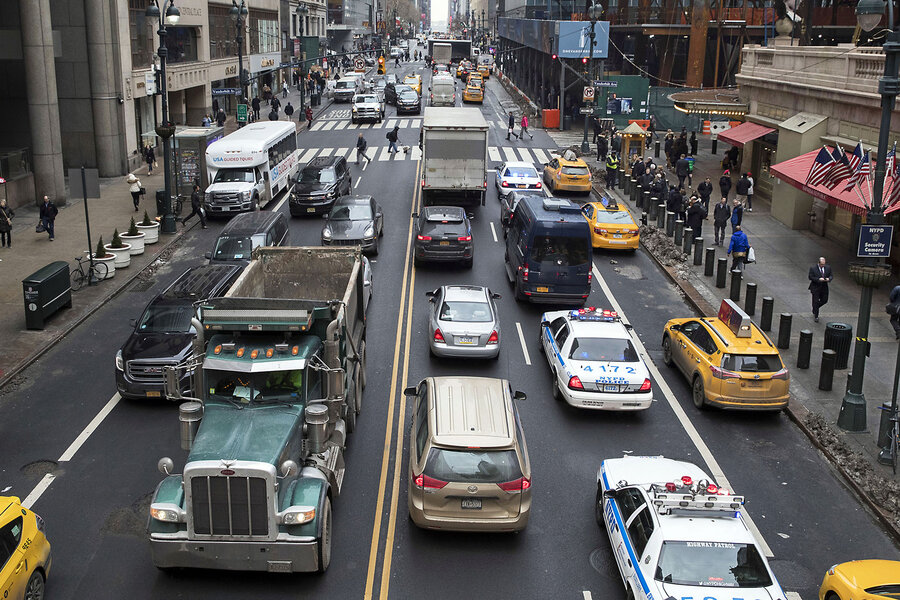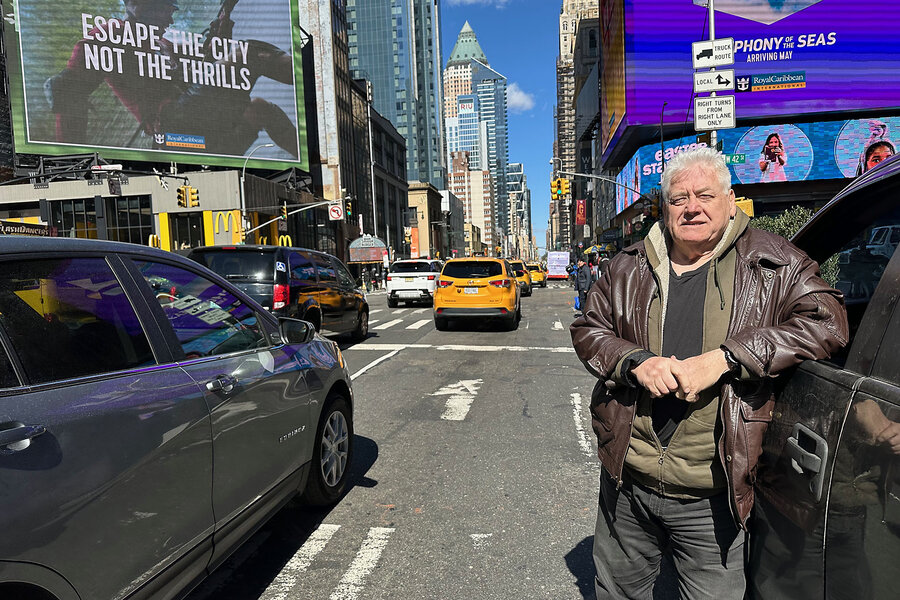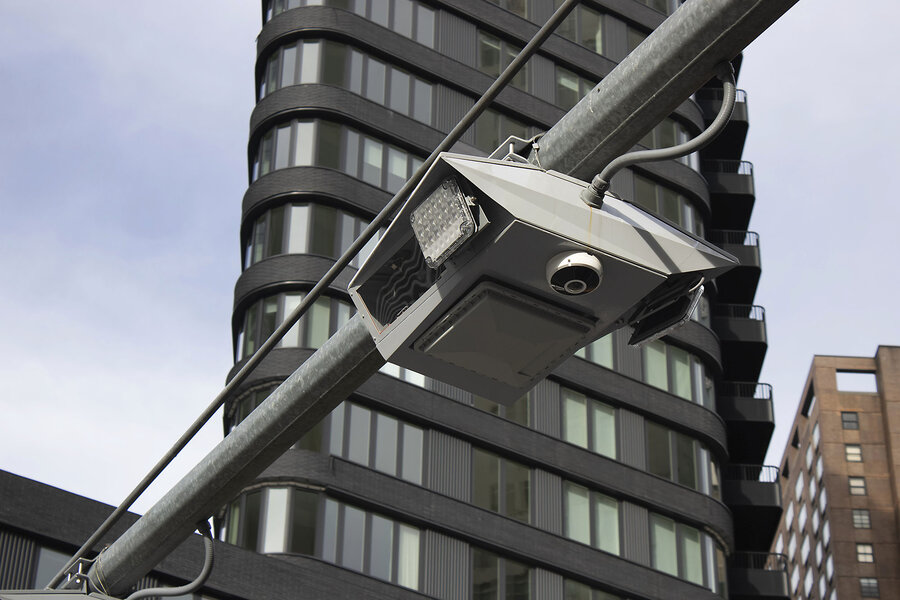Why drivers may soon pay $15 to use New York’s busiest streets
Loading...
| New York
In June, New York is due to become the first U.S. city to charge a fee on cars and trucks as they enter its central business district in Manhattan, potentially raising billions of dollars to upgrade the city’s buses and subway lines.
New York’s congestion toll follows similar moves in cities like London, Milan, and Singapore. While it signals local ambitions to lessen traffic gridlock, reduce the carbon footprint of private vehicles, and nudge more people onto public transport, it also runs headlong into the global political debate about climate action’s cost and who pays the price.
Why We Wrote This
A story focused onA global shift in urban planning – from private to public transit – has yet to take hold in the U.S. New York could be a test case for this shift and for public support for big-city congestion charges.
In New York, government studies say congestion pricing will reduce traffic by 17% in Manhattan’s 9-square-mile congestion zone, lowering pollution. But implementation is not yet a go. Lawsuits could stall it. One concern is that drivers will skirt Manhattan’s congestion zone and switch to routes through the South Bronx.
If your goal is to reduce congestion, a charge is the right approach, says Nicholas Klein, a Cornell University urban planning professor. “Now, we pay a lot to drive in congested areas. We just pay with our time.”
In June, New York is due to become the first U.S. city to charge a congestion toll on drivers entering its central business district in Manhattan, potentially raising billions of dollars to upgrade the city’s buses and subway that handle 4.6 millions trips a day.
Almost two decades in the making, New York’s congestion toll follows similar moves in cities like London, Milan, and Singapore. It signals local ambitions to lessen traffic gridlock, reduce the carbon footprint of private vehicles, and nudge more people onto public transport. It also runs headlong into the global political debate about climate action’s cost and who pays the price.
Advocates point to government studies that say congestion fees will reduce traffic by 17% in the roughly 9-square-mile congestion zone, thus lowering pollution. On weekdays, around 700,000 vehicles traverse the designated area from Central Park at 60th Street south to Battery Park.
Why We Wrote This
A story focused onA global shift in urban planning – from private to public transit – has yet to take hold in the U.S. New York could be a test case for this shift and for public support for big-city congestion charges.
“We’re more than ready for congestion pricing,” says Jon Orcutt, transportation policy director under former Mayor Michael Bloomberg, whose administration first proposed the plan in 2007. He says traffic and car ownership in the city now exceeds pre-COVID levels, and the crush of Ubers, Lyfts, and just-in-time deliveries compounds snarls.
The New York State Legislature approved congestion tolls in 2019, but implementation was delayed by the pandemic, regulatory red tape, and lawsuits. The Metropolitan Transportation Authority (MTA) board voted last week to launch the plan, which still faces legal challenges.
Officials estimate the new toll would raise $1 billion a year to help pay for transit infrastructure, including extending the Second Avenue subway line to Harlem, making subway stations more accessible and further modernizing the aging system.
Most passenger vehicles will pay $15 to enter the district. Trucks will pay more, and motorcycles less, with discounts from 9 p.m. to 5 a.m. Taxi and app-based ride customers will pay an extra $1.25 and $2.50, respectively. Hard-pressed cabbies fear that tips will shrink even further, coming atop a prior $2.50 congestion fee for trips south of 96th Street. Cars using Franklin D. Roosevelt Drive and the West Side Highway don’t have to pay. Residents who live inside the zone and drive out must pay the toll to return.
There are also exemptions for emergency and government vehicles, as well as for yellow school buses; advocates say reduced congestion would speed journey times for those vehicles.
Many in this city of skeptics question how well the MTA will spend the money, given its history of mismanagement, graft, and opacity.
“They’ve never used their money responsibly before,” says Alex Roth, a building contractor who drives into the zone almost daily. ”There’s no reason to think they’re going to do it now.” A longtime Manhattan resident, he says the MTA has failed to deliver on previous promises for a cleaner and faster transit system.
Paying with our time
Supporters of the new toll say the MTA’s new leadership makes it better positioned to invest new revenues in the system.
Gersh Kuntzman, editor of Streetsblog, which favors a less car-reliant city, says public transit improvements are already apparent. “If people don’t see them, it’s because they’re in their cars,” he says.
If the goal is to reduce congestion, a charge is the right approach, says Cornell University urban planning professor Nicholas Klein. “Now, we pay a lot to drive in congested areas. We just pay with our time.”
New York City had the worst traffic in America last year. But while most residents agree that traffic congestion is a serious problem, a 2019 Quinnipiac University poll found that fewer than half supported tolls, and many doubted it would reduce traffic in the designated zone.
Former Gov. Andrew Cuomo, who signed the congestion toll legislation in 2019, wrote recently in the New York Post that the plan should be delayed. He called for more research, and said riders don’t feel safe taking the subway.
Implementation is not yet a go. Lawsuits, including ones from the borough of Staten Island and New Jersey, could stall it. One concern is that drivers will skirt Manhattan’s congestion zone and switch to routes through the South Bronx. This poor, primarily nonwhite area already struggles with ailments like asthma, which health experts link to pollution from the multiple highways and freeways that crisscross the borough. The MTA says it will spend millions of dollars to improve air quality near the Bronx highways.
A post-Moses mindset
The congestion plan is part of a shift in global mindset toward more pedestrian- and bike-friendly urban environments. It’s a 180-degree turn from how New York was remade after World War II under influential urban planner Robert Moses. He designed roads, bridges, and tunnels that funneled automobiles throughout the city’s five boroughs – all while pointedly ignoring public transportation. His projects often came at the expense of marginalized groups, particularly in the Bronx, where Mr. Moses sliced and diced poor neighborhoods to build highways.
Kevin Smith is a regular on these roads. His family owns a farm in Middletown, so half the year he drives a 24-foot truck into Manhattan to sell vegetables, strawberries, and peaches at an outdoor market. He says higher tolls are just a cost of doing business.
“Every change they have made in my lifetime has made an overall improvement to traffic flow and quality of life in Manhattan,” Mr. Smith says, citing the conversion of parts of streets like Broadway to pedestrian-only sectors.
Still, the idea that American drivers, long used to unfettered access to a continent-spanning road system, would accept paying a toll to enter downtown zones seems foreign, which is why cities are watching New York’s experiment with congestion pricing.
“If you’re used to driving and not paying a charge and somebody puts a charge on your drive, that can feel like a violation of your rights,” says Peter Norton, a historian and author of “Fighting Traffic: The Dawn of the Motor Age in the American City.” “Americans grow up driving.”









